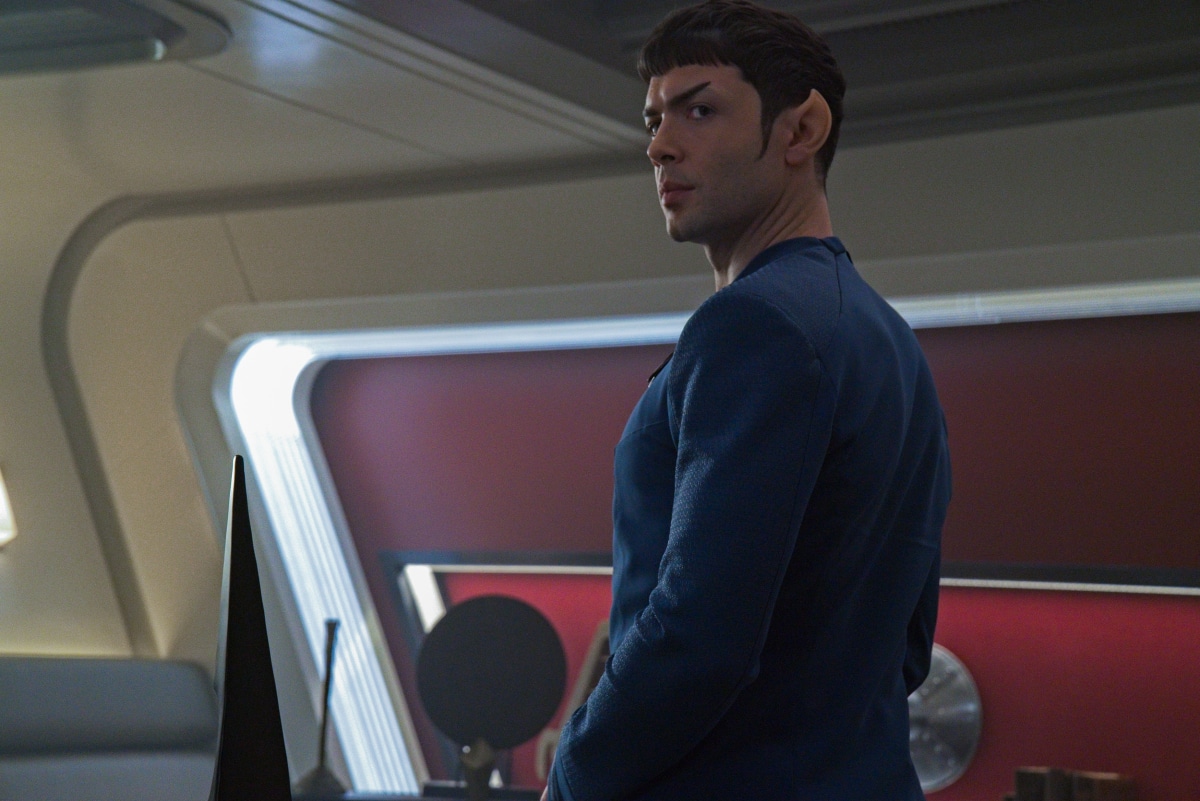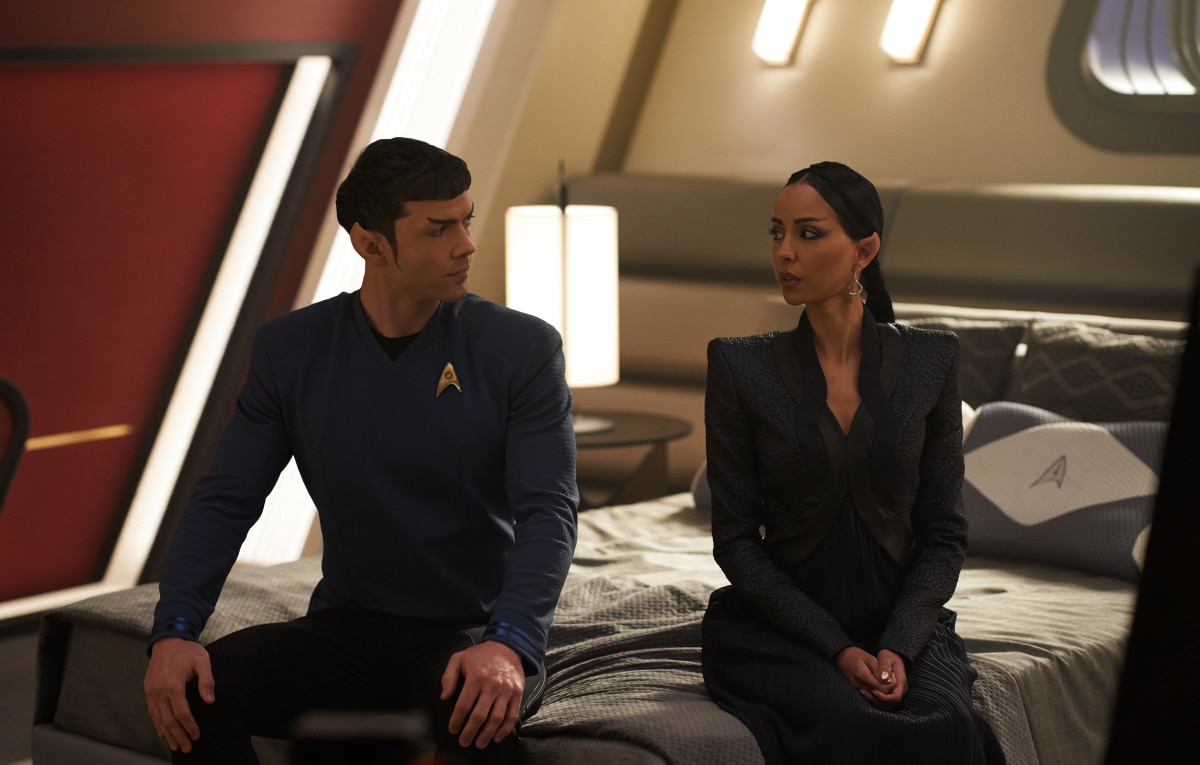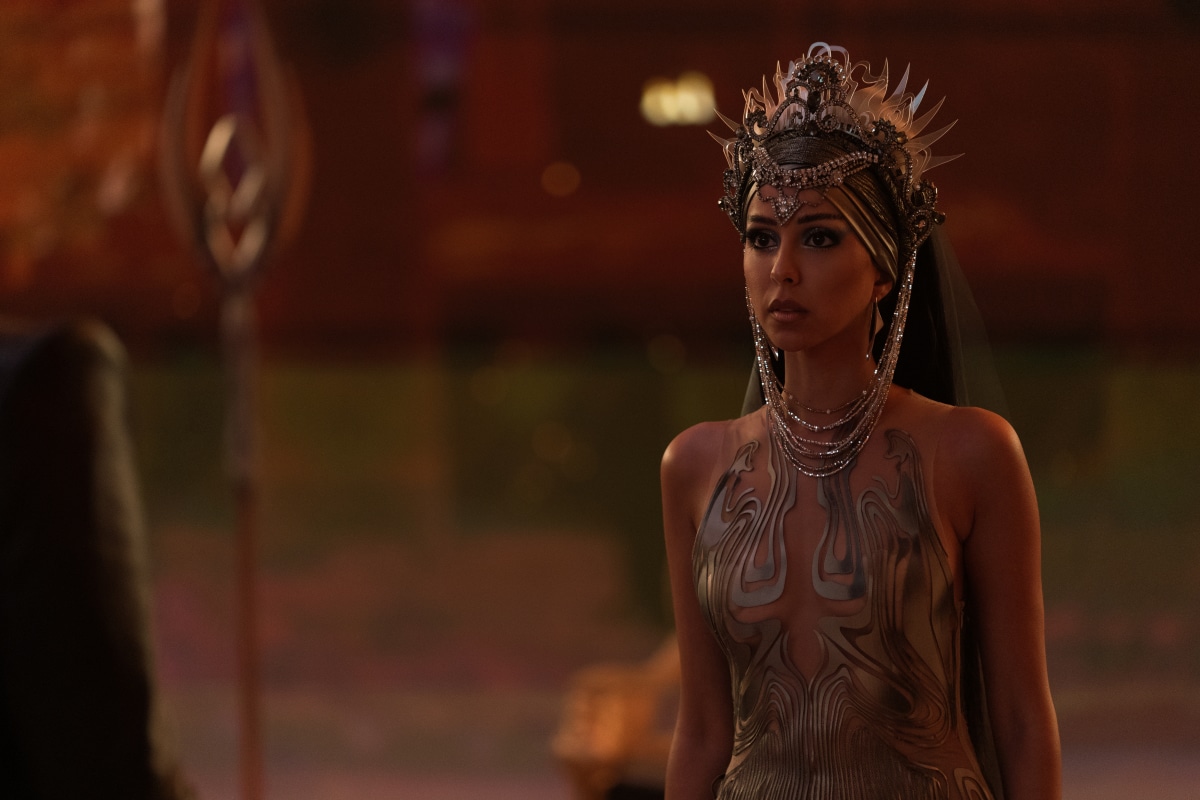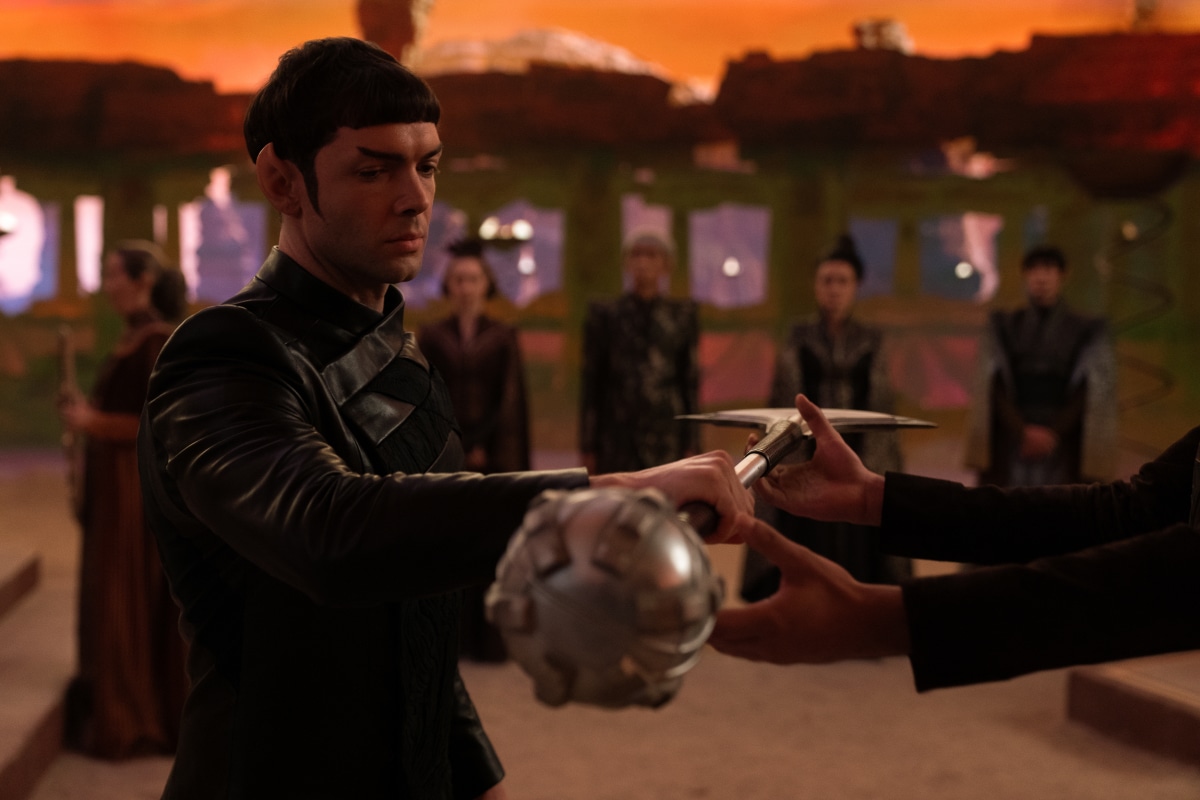This discussion and review contains spoilers for Star Trek: Strange New Worlds episode 5, “Spock Amok.”
“Spock Amok” has a certain goofy charm to it, in that there’s something endearing in seeing Strange New Worlds commit so hard to a time-honored Star Trek tradition: the very embarrassing comedy episode.
It seems fair to concede that the Star Trek franchise has a somewhat mixed track record when it comes to comedy. Despite Gene Roddenberry’s protestations, the original Star Trek could be pretty funny thanks to the work of producer Gene L. Coon and writer David Gerrold on episodes like “I, Mudd” and “The Trouble with Tribbles.” There is a reason why The Voyage Home is widely accepted as one of the most beloved Star Trek movies, particularly among casual audiences.
In contrast, The Next Generation struggled to make its comedy land. This led to disasters like “The Outrageous Okona” or “Ménage à Troi.” Even the funniest episodes of The Next Generation required a certain tolerance for goofiness, like “A Fistful of Datas.” While Voyager managed episodes like “Bride of Chaotica!” and “Tinker Tenor Doctor Spy,” it was also responsible for stories like “Fair Haven” and “Spirit Folk.”
Deep Space Nine probably fared the best of any of the spinoffs. It produced some of the funniest episodes in the franchise: “The House of Quark,” “Little Green Men,” “Our Man Bashir,” “Trials and Tribble-ations,” “In the Cards,” and “The Magnificent Ferengi.” However, this was largely a numbers game, with the show also producing disasters like “Prophet Motive,” “One Little Ship,” or “The Emperor’s New Cloak.” The show was far from consistent with its comedy.

One of the more interesting aspects of the franchise’s approach to humor is the tendency to try to mine it from broad body comedy. This is likely an attempt to capitalize on the franchise’s science fiction framework, trying to mine gags related to the high concepts that drive the franchise. The result is that Star Trek often recycles gags that were probably mildly amusing in 1950s genre fiction but that seemed trite and familiar by the time that the franchise entered the 1990s.
There are any number of obvious examples. “Rascals” is a comedy that imagines what it might be like for characters like Picard (Patrick Stewart) and Guinan (Whoopi Goldberg) to suddenly find their consciousness inside their childhood bodies. “Body and Soul” imagines the EMH (Robert Picardo) taking control of Seven of Nine’s (Jeri Ryan) body. In “Unexpected,” Charles “Trip” Tucker (Connor Trinneer) ends up pregnant after an amorous encounter with an alien.
It is a very basic form of humor, built around the idea that human bodies are inherently ridiculous. It is notable that many of these examples also include a broad gender-swap element, playing into the idea that it is inherently absurd for men to experience life as women. “Profit and Lace” finds Quark (Armin Shimerman) stuck in a surgically enhanced drag performance playing his own mother. It is somehow even more horrifying and embarrassing than that premise suggests.
As such, “Spock Amok” is a worthy addition to the canon of “questionable Star Trek comedy episodes,” even managing to hit some of the surprisingly specific trends within the subgenre. “Spock Amok” is a body swap episode, which finds Spock (Ethan Peck) swapping bodies with his betrothed T’Pring (Gia Sandhu). While “Spock Amok” avoids the worst impulses of something like “Profit and Lace,” comedy ensues as the two characters each end up with an appreciation of the other’s life.

“Spock Amok” isn’t particularly funny. This isn’t necessarily a criticism, as it wouldn’t feel like an homage to episodes like “Rascals” or “A Fistful of Datas” if it were entirely successful as a comedy. Instead, the episode’s commitment to its central high concept becomes endearing, and the show’s attempts at deadpan humor are oddly charming because they never insist upon themselves too forcefully. “It appears that hijinks are the most logical course of action,” notes Spock at one point.
To be fair, “Spock Amok” runs into a common problem facing Star Trek shows when casting Vulcans. It is very difficult to cast Vulcan characters particularly well because it is easy to mistake Vulcans as emotionless rather than simply repressed. The best actors playing Vulcans have carefully calibrated and measured their performances, essentially layering the performance of stoicism on top of a rich internal life. The worst actors playing Vulcans portray these characters as talking computers.
Over the course of the larger Star Trek franchise, few actors have managed to strike that balance. The original Star Trek got remarkably lucky with both Mark Lenard and Leonard Nimoy. Both The Next Generation and Deep Space Nine struggled when casting guest actors as Vulcans. Tim Russ gave an underappreciated performance as Tuvok on Voyager. Gary Graham’s work as Soval was an unsung highlight of Enterprise. Zachary Quinto was superb in the Abrams Star Trek movies.
“Spock Amok” suffers because neither Peck nor Sandhu is quite at that level. As on Discovery, Peck’s performance as Spock suffers because he is not quite as compelling as either Nimoy or Quinto, and the decision to layer a body swap on top of this doesn’t make matters easier. These sorts of comedies live or die by central performances, with Robert Picardo anchoring “Tinker Tenor Doctor Spy” and “Body and Soul” working to the extent that it does because of Jeri Ryan.

That said, “Spock Amok” is still basically functional in the way that Strange New Worlds is consistently reliable. In particular, there is a nice thematic thread running through the episode, tethering the primary, secondary, and tertiary subplots. At its core, “Spock Amok” is a story about the importance of empathy, of understanding other perspectives. It is, appropriately enough for the show’s first Spock-centric episode, a story about “Infinite Diversity in Infinite Combinations.”
It is a welcome counterbalance to the reactionary themes of “Memento Mori,” an episode that rejected the very idea of empathy when dealing with an alien species. In “Spock Amok,” Spock and T’Pring literally walk in one another’s shoes. Meanwhile, Number One (Rebecca Romijn) and Noonien-Singh (Christina Chong) play “Enterprise Bingo” to experience life as new recruits do, while Pike (Anson Mount) is only able to negotiate with the Rongovians by embracing “radical empathy.”
Interestingly, “Spock Amok” marks a return to the more intriguing subtext of “Ghosts of Illyria,” with its in-built skepticism about the Federation as an institution. Pike is only able to make a diplomatic breakthrough when he considers how the Federation looks to outsiders and that it is not an entity acting out of selflessness. “The Federation has lots to offer, sure, but it always exacts a price,” he explains. “You have good reason to suspect that price is too high for you to pay.”
It’s a small touch in a largely comedic episode, but it still represents a sizable step for the modern iteration of Star Trek, which tends to view Starfleet and the Federation in an uncritical manner. Strange New Worlds has repeatedly suggested these institutions cause as many problems as they solve, creating a massive mess on Kylie-279 in “Strange New Worlds” and demonstrating systemic racism against Illyrians in “Ghosts of Illyria.” It would be nice to see the show develop this.

There are other charming details in “Spock Amok.” It is fascinating to watch T’Pring at work as a Vulcan law enforcement official, and there’s something clever in the idea that Vulcan law enforcement seems to largely consist of officials debating suspects into submission, using logic and reason to convince them to submit to rehabilitation and to mend their ways. It is perhaps the funniest gag in the episode, and it is unrelated to the episode’s central high concept.
While “Spock Amok” demonstrates the same strengths as earlier episodes, it also demonstrates the same weaknesses. The episode is far too steeped in nostalgia, opening with an extended homage to “Amok Time.” The franchise has done its share of body-swap episodes, from “Turnabout Intruder” to “Vis à Vis.” Even the “difficult ambassadors” subplot is a Star Trek staple: “Liaisons,” “Man of the People,” “Journey to Babel,” “Sarek,” “Violations,” “Fallen Hero,” and so on.
The problem is not that some of these elements feel vaguely familiar. There are over 700 episodes of Star Trek; it is inevitable that certain elements will repeat themselves. The problem is that Strange New Worlds doesn’t seem especially interested in even trying to do something new or interesting with these elements. A frustrating amount of space in any proper review of Strange New Worlds must inevitably be given over to listing Star Trek episodes that did the same thing, frequently better.
That said, there are suggestions of the return of more fundamental problems in “Spock Amok.” Strange New Worlds has leaned heavily into episodic and self-contained storytelling, and “Spock Amok” demonstrates how committed the show is to that premise. The Enterprise was badly damaged in “Memento Mori,” but it’s all easily fixed with a trip to a station in “Spock Amok.” It recalls the way that Voyager and the early seasons of Enterprise would treat damage to the ship.
This approach extends to characterization. In “Ghosts of Illyria,” it was revealed that M’Benga (Babs Olusanmokun) keeps his daughter in the Sickbay transporter buffer, so it seems strange for him to leave her alone in that system to have goofy adventures on shore leave. Literally the only thing that the audience knows about M’Benga at this point is that his daughter is in the transporter buffer and that he is (understandably) highly protective of her. That is undercut for a shot of him in a goofy hat.
As Star Trek: Strange New Worlds approaches its midseason, “Spock Amok” demonstrates that the show has at least found a central identity. It is a show that very much aspires to resurrect the Berman era of Star Trek and offers a convincing imitation of its later years. This isn’t a body swap so much as it is necromancy, but there is something of a grim joke to it.





